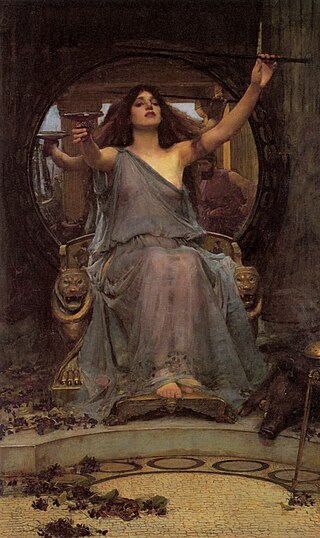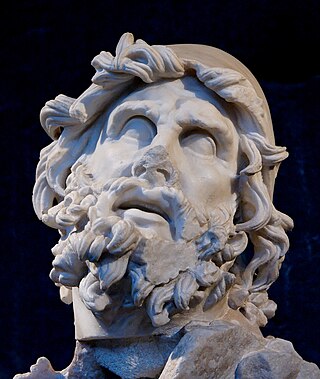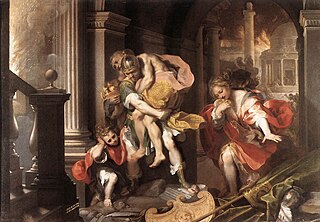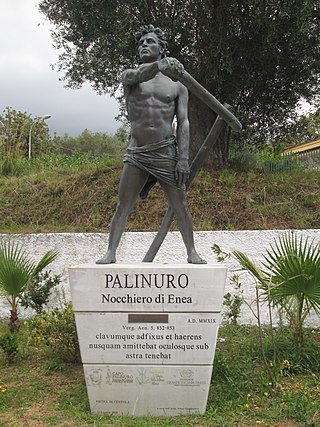
Circe is an enchantress and a minor goddess in ancient Greek mythology and religion. In most accounts, Circe is described as the daughter of the sun god Helios and the Oceanid nymph Perse. Circe was renowned for her vast knowledge of potions and herbs. Through the use of these and a magic wand or staff, she would transform her enemies, or those who offended her, into animals.

The Odyssey is one of two major ancient Greek epic poems attributed to Homer. It is one of the oldest works of literature still widely read by modern audiences. Like the Iliad, the Odyssey is divided into 24 books. It follows the Greek hero Odysseus, king of Ithaca, and his journey home after the Trojan War. After the war, which lasted ten years, his journey from Troy to Ithaca, via Africa and southern Europe, lasted for ten additional years during which time he encountered many perils and all of his crewmates were killed. In his absence, Odysseus was assumed dead, and his wife Penelope and son Telemachus had to contend with a group of unruly suitors who were competing for Penelope's hand in marriage.

In Greek and Roman mythology, Odysseus, also known by the Latin variant Ulysses, is a legendary Greek king of Ithaca and the hero of Homer's epic poem, the Odyssey. Odysseus also plays a key role in Homer's Iliad and other works in that same epic cycle.

The Aeneid is a Latin epic poem that tells the legendary story of Aeneas, a Trojan who fled the fall of Troy and travelled to Italy, where he became the ancestor of the Romans. Written by the Roman poet Virgil between 29 and 19 BC, the Aeneid comprises 9,896 lines in dactylic hexameter. The first six of the poem's twelve books tell the story of Aeneas' wanderings from Troy to Italy, and the poem's second half tells of the Trojans' ultimately victorious war upon the Latins, under whose name Aeneas and his Trojan followers are destined to be subsumed.

In Greek mythology, Telemachus is the son of Odysseus and Penelope, who are central characters in Homer's Odyssey. When Telemachus reached manhood, he visited Pylos and Sparta in search of his wandering father. On his return to Ithaca, he found that Odysseus had reached home before him. Then father and son slew the suitors who had gathered around Penelope. According to later tradition, Telemachus married Circe after Odysseus's death.

Aeaea, Ææa or Eëä was a mythological island said to be the home of the goddess-sorceress Circe.
"Circe would fain have held me back in her halls, the guileful lady of Aeaea, yearning that I should be her husband"..

Lake Avernus is a volcanic crater lake located in the Avernus crater in the Campania region of southern Italy, around 4 kilometres west of Pozzuoli. It is near the volcanic field known as the Phlegraean Fields and comprises part of the wider Campanian volcanic arc. The lake is roughly circular, measuring two kilometres in circumference and 60 metres (200 ft) deep.
The Telegony is a lost ancient Greek epic poem about Telegonus, son of Odysseus by Circe. His name is indicative of his birth on Aeaea, far from Odysseus' home of Ithaca. It was part of the Epic Cycle of poems that recounted the myths of the Trojan War as well as the events that led up to and followed it. The story of the Telegony comes chronologically after that of the Odyssey and is the final episode in the Epic Cycle. The poem was sometimes attributed in antiquity to Cinaethon of Sparta, but in one source it is said to have been stolen from Musaeus by Eugamon or Eugammon of Cyrene. The poem comprised two books of verse in dactylic hexameter.

A katabasis or catabasis is a journey to the underworld. Its original sense is usually associated with Greek mythology and classical mythology more broadly, where the protagonist visits the Greek underworld, also known as Hades. The term is also used in a broad sense of any journey to the realm of the dead in other mythological and religious traditions. A katabasis is similar to a nekyia or necromancy, where one experiences a vision of the underworld or its inhabitants; a nekyia does not generally involve a physical visit. One of the most famous examples is that of Odysseus, who performs something on the border of a nekyia and a katabasis in book 11 of the Odyssey; he visits the border of the realms before calling the dead to him using a blood rite, with it being disputed whether he was at the highest realm of the underworld or the lowest edge of the living world where he performed this.

The Odyssey is a 1997 American mythology–adventure television miniseries based on the ancient Greek epic poem by Homer, the Odyssey. Directed by Andrei Konchalovsky and co-produced by Hallmark Entertainment and American Zoetrope, the miniseries aired in two parts beginning on May 18, 1997, on NBC. It was filmed in Malta, Turkey, parts of England and many other places around the Mediterranean, where the story takes place. The cast includes Armand Assante, Greta Scacchi, Irene Papas, Isabella Rossellini, Bernadette Peters, Eric Roberts, Geraldine Chaplin, Jeroen Krabbé, Christopher Lee and Vanessa Williams.

In ancient Greek cult-practice and literature, a nekyia or nekya is a "rite by which ghosts were called up and questioned about the future," i.e., necromancy. A nekyia is not necessarily the same thing as a katabasis. While they both afford the opportunity to converse with the dead, only a katabasis is the actual, physical journey to the underworld undertaken by several heroes in Greek and Roman myth.
The Odyssean gods are the ancient Greek gods referenced in Homer's Odyssey.

The Returns from Troy are the stories of how the Greek leaders returned after their victory in the Trojan War. Many Achaean heroes did not return to their homes, but died or founded colonies outside the Greek mainland. The most famous returns are those of Odysseus, whose wanderings are narrated in the Odyssey, and Agamemnon, whose murder at the hands of his wife Clytemnestra was portrayed in Greek tragedy.

In poetry and literature, a shade is the spirit or ghost of a dead person, residing in the underworld.

The locations mentioned in the narratives of Odysseus's adventures have long been debated. Events in the main sequence of the Odyssey take place in the Peloponnese and in what are now called the Ionian Islands. There are also incidental mentions of Troy and its house, Phoenicia, Egypt, and Crete, which hint at a geographical knowledge equal to, or perhaps slightly more extensive than that of the Iliad. The places visited by Odysseus in his journey have been variously identified with locations in Greece, Italy, Tunisia, the Maltese archipelago, and the Iberian peninsula. However, scholars both ancient and modern are divided whether any of the places visited by Odysseus were real. Many ancient writers came down squarely on the skeptical side; Strabo reported what the great geographer Eratosthenes had said in the late 3rd century BC: "You will find the scene of Odysseus' wanderings when you find the cobbler who sewed up the bag of winds."
The gates of horn and ivory are a literary image used to distinguish true dreams from false. The phrase originated in the Greek language, in which the word for "horn" is similar to that for "fulfill" and the word for "ivory" is similar to that for "deceive". On the basis of that play on words, true dreams are spoken of as coming through the gates of horn, false dreams as coming through those of ivory.

Palinurus (Palinūrus), in Roman mythology and especially Virgil's Aeneid, is the coxswain of Aeneas' ship. Later authors used him as a general type of navigator or guide. Palinurus is an example of human sacrifice; his life is the price for the Trojans landing in Italy.
Mission Odyssey is a French-German animated TV series about the adventures of the ancient Greek hero Ulysses. The series is a production of BAF Berlin Animation Film GmbH & Co. Productions KG, Marathon Filmproduction, Marathon Animation, and M6 Metropole Television. Character design was created by David Gilson. Distributional rights were acquired in 2009 by the Your Family Entertainment AG, which is now holding indefinite broadcast rights including ancillary rights for almost all countries. Its global premiere took place on the French network M6 on 6 September 2002. In Germany, the show was launched on 22 February 2008 on KIKA.
A pelike was a ceramic container that the Greeks used as storage/transportation for wine and olive oil. As seen in the picture on the right, it had a large belly with thin, open handles. Unlike other transportation jars, a pelike would have a flattened bottom so that it could stand on its own. Pelikes often had one large scene across the belly of the jar with minimal distractions around. This would focus the viewers eyes to the center of the pelike which was often a mythological scene of sorts.
Eneide is a seven-episode 1971–1972 Italian television drama, adapted by Franco Rossi from Virgil's epic poem the Aeneid. It stars Giulio Brogi as Aeneas and Olga Karlatos as Dido, and also stars Alessandro Haber, Andrea Giordana and Marilù Tolo. RAI originally broadcast the hour-long episodes from 19 December 1971 to 30 January 1972. A shorter theatrical version was released in 1974 as Le avventure di Enea.













